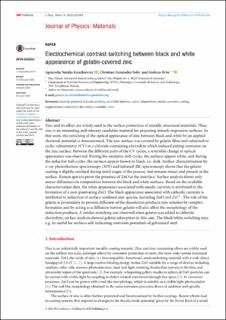| dc.contributor.author | Ksiazkiewicz, Agnieszka Natalia | |
| dc.contributor.author | Fernandez-Solis, Christian | |
| dc.contributor.author | Erbe, Andreas | |
| dc.date.accessioned | 2020-05-20T12:35:38Z | |
| dc.date.available | 2020-05-20T12:35:38Z | |
| dc.date.created | 2020-05-06T15:54:51Z | |
| dc.date.issued | 2020 | |
| dc.identifier.uri | https://hdl.handle.net/11250/2655191 | |
| dc.description.abstract | Zinc and its alloys are widely used in the surface protection of metallic structural materials. Thus, zinc is an interesting and relevant candidate material for preparing stimuli-responsive surfaces. In this work, the switching of the optical appearance of zinc between black and white by an applied electrode potential is demonstrated. The zinc surface was covered by gelatin films and subjected to cyclic voltammetry (CV) in a chloride-containing electrolyte which induced pitting corrosion on the zinc surface. Between the different parts of the CV cycles, a reversible change in optical appearance was observed. During the oxidative half-cycles, the surfaces appear white, and during the reductive half-cycles, the surfaces appear brown to black, i.e. dark. Surface characterisation by x-ray photoelectron spectroscopy (XPS) and infrared (IR) spectroscopy shows that the gelatin coating is slightly oxidised during intial stages of the process, but remains intact and present at the surface. Raman spectra prove the presence of ZnO at the interface. Surface analysis shows only minor differences in composition between the black and white surfaces. Based on the available characterisation data, the white appearance associated with anodic currents is attributed to the formation of a non-passivating ZnO. The black appearance associated with cathodic currents is attributed to reduction of surface-confined zinc species, including ZnO and Zn2+. The role of the gelatin is presumably to prevent diffusion of the dissolution products into solution by complex formation and by acting as a diffusion barrier; gelatin will also affect the morphology of the reduction products. A similar switching was observed when gelatin was added to chloride electrolyte; surface analysis showed gelatin adsorption in this case. The black/white switching may, e.g. be useful for surfaces self-indicating corrosion potentials of galvanised steel. | en_US |
| dc.language.iso | eng | en_US |
| dc.publisher | IOP | en_US |
| dc.rights | Navngivelse 4.0 Internasjonal | * |
| dc.rights.uri | http://creativecommons.org/licenses/by/4.0/deed.no | * |
| dc.title | Electrochemical contrast switching between black and white appearance of gelatin-covered zinc | en_US |
| dc.type | Peer reviewed | en_US |
| dc.type | Journal article | en_US |
| dc.description.version | publishedVersion | en_US |
| dc.source.volume | 3 | en_US |
| dc.source.journal | JPhys Materials | en_US |
| dc.identifier.doi | 10.1088/2515-7639/ab7cba | |
| dc.identifier.cristin | 1809700 | |
| dc.description.localcode | Original Content from this work may be used under the terms of the Creative Commons Attribution 4.0 licence. Any further distribution of this work must maintain attribution to the author(s) and the title of the work, journal citation and DOI. | en_US |
| cristin.ispublished | true | |
| cristin.fulltext | original | |
| cristin.fulltext | postprint | |
| cristin.qualitycode | 1 | |

